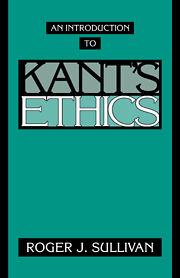Book contents
- Frontmatter
- Contents
- Introduction
- 1 A Beginning: Kant's Political Theory
- 2 The Categorical Imperative: The Ultimate Norm of Morality
- 3 The Formula of Autonomy or of Universal Law
- 4 The Formula of Respect for the Dignity of Persons
- 5 The Formula of Legislation for a Moral Community
- 6 The Limits of the Categorical Imperative
- 7 Morality and Prudence (Foundations 2)
- 8 Moral Character
- 9 Living under the Moral Law
- 10 The Defense of Morality (Foundations 3)
- Suggestions for Further Reading
- Index
7 - Morality and Prudence (Foundations 2)
Published online by Cambridge University Press: 05 November 2009
- Frontmatter
- Contents
- Introduction
- 1 A Beginning: Kant's Political Theory
- 2 The Categorical Imperative: The Ultimate Norm of Morality
- 3 The Formula of Autonomy or of Universal Law
- 4 The Formula of Respect for the Dignity of Persons
- 5 The Formula of Legislation for a Moral Community
- 6 The Limits of the Categorical Imperative
- 7 Morality and Prudence (Foundations 2)
- 8 Moral Character
- 9 Living under the Moral Law
- 10 The Defense of Morality (Foundations 3)
- Suggestions for Further Reading
- Index
Summary
So far we have examined Kant's analysis of the role and scope of the Categorical Imperative in determining the morality of our maxims or practical policies. In this chapter, we will approach his theory of moral life from a new and different perspective, by setting out the contrast he made between morality and prudence in the second section of the Foundations. We will do this by first looking at his general description of our ability to direct our actions intelligently, then examining his account of prudence, and finally seeing how, in his judgment, morality is radically different from prudence. Taking this approach will give us the opportunity to consider Kant's analysis of maxims from a different focus.
PRACTICAL REASON IN GENERAL
We can relate to the world in two very different ways. We do so theoretically, as observers, when we seek only to understand the world; and we do so practically, as agents, when we try to change the world to what we want it to be or think it ought to be (387). Traditionally, Western philosophy had taken our ability to reason to be the distinctive feature of human agency. Kant stood firmly within that tradition, and in the second section of the Foundations he discussed how our agency is guided by what, in his faculty psychology, he referred to, interchangeably, as “practical reason” and the “will” (412; see 446). This is the power we have to select goals in which we are interested, to form rules for achieving them, and finally to act on those rules.
Identifying goals. As Kant saw it, there are no rational actions that are completely aimless; we cannot act rationally without an end in view (387).
- Type
- Chapter
- Information
- An Introduction to Kant's Ethics , pp. 114 - 129Publisher: Cambridge University PressPrint publication year: 1994



